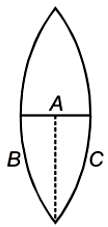A thin equiconvex lens of power P is cut into three parts A, B, and C as shown in the figure. If P1, P2, and P3 are powers of the three parts respectively, then:

1.
\(P_1=P_2=P_3\)
2.
\(P_1>P_2=P_3\)
3.
\(P_1<P_2=P_3\)
4.
\(P_2=P_3=2P_1\)

A point source of light B is placed at a distance L in front of the centre of a mirror of width d hung vertically on a wall. A man walks in front of the mirror along a line parallel to the mirror at a distance 2L from it as shown. The greatest distance over which he can see the image of the light source in the mirror is:
1. d/2
2. d
3. 2d
4. 3d
The focal length of the objective lens and the eye lens is 4 mm and 25 mm respectively in a compound microscope. The distance between objective and eyepiece lens is 16 cm. Find its magnifying power for relaxed eye position:
| 1. | 32.75 |
| 2. | 327.5 |
| 3. | 0.3275 |
| 4. | None of the above |
A medium shows relation between i and r as shown. If the speed of light in the medium is nc then the value of n is:
1. 1.5
2. 2
3. 2–1
4. 3–1/2
A person can see clearly objects only when they lie between 50 cm and 400 cm from his eyes. In order to increase the maximum distance of distinct vision to infinity, the type and power of the correcting lens, the person has to use will be:
| 1. | Convex, +2.25 D |
| 2. | Concave, - 0.25 D |
| 3. | Concave, - 0.2 D |
| 4. | Convex, + 0.15 D |
In an astronomical telescope in normal adjustment a straight black line of length \(L\) is drawn on inside part of the objective lens. The eye-piece forms a real image of this line. The length of this image is \(l\). The magnification of the telescope is:
1. \(\frac{L}{l+1}\)
2. \(\frac{L}{l-1}\)
3. \(\frac{L+1}{L-1}\)
4. \(\frac{L}{l}\)
For the angle of minimum deviation of a prism to be equal to its refracting angle, the prism must be made of a material whose refractive index:
| 1. | lies between\(\sqrt{2} \text { and } 1 \text {. }\) |
| 2. | lies between 2 and \(\sqrt{2} \) |
| 3. | is less than 1. |
| 4. | is greater than 2. |
A converging beam of rays is incident on a diverging lens. Having passed through the lens the rays intersect at a point \(15~\mathrm{cm}\) from the lens on the opposite side. If the lens is removed the point where the rays meet will move 5 cm closer to the lens. The focal length of the lens is:
| 1. | -10 cm | 2. | 20 cm |
| 3. | -30 cm | 4. | 5 cm |
The speed of light in media and is and respectively. A ray of light enters from medium to at an incidence angle i. If the ray suffers total internal reflection, the value of i is:
| 1. | equal to \(\sin ^{-1}\left(\frac{2}{3}\right)\) |
| 2. | equal to or less than \(\sin ^{-1}\left(\frac{3}{5}\right)\) |
| 3. | equal to or greater than \(\sin ^{-1}\left(\frac{3}{4}\right)\) |
| 4. | less than \(\sin ^{-1}\left(\frac{2}{3}\right)\) |
A boy is trying to start a fire by focusing sunlight on a piece of paper using an equiconvex lens of focal length 10 cm. The diameter of the sun is \(1.39\times 10^9~\text{m}\) and its mean distance from the earth is . What is the diameter of the sun's image on the paper?
1. \(
9.2 \times 10^{-4} \mathrm{~m}
\)
2. \(6.5 \times 10^{-4} \mathrm{~m}
\)
3. \(6.5 \times 10^{-5} \mathrm{~m}
\)
4. \( 12.4 \times 10^{-4} \mathrm{~m}\)




